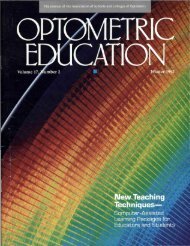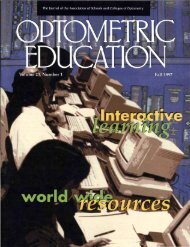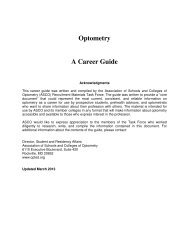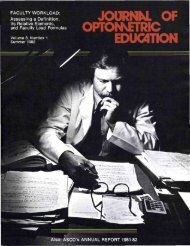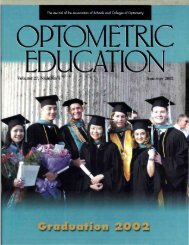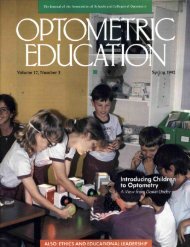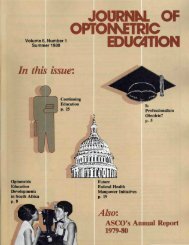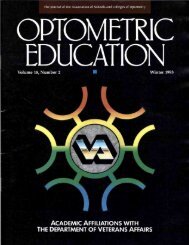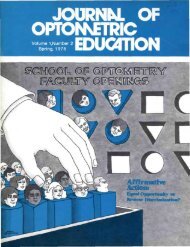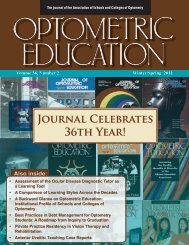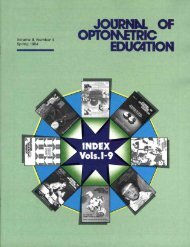Summer 2012, Volume 37, Number 3 - Association of Schools and ...
Summer 2012, Volume 37, Number 3 - Association of Schools and ...
Summer 2012, Volume 37, Number 3 - Association of Schools and ...
Create successful ePaper yourself
Turn your PDF publications into a flip-book with our unique Google optimized e-Paper software.
when given a choice, patients subconsciously<br />
prefer <strong>and</strong> choose a clinician<br />
<strong>of</strong> the same race. 3-5,9,10 Giving patients<br />
choice <strong>of</strong>ten reveals unspoken sex, race<br />
<strong>and</strong> ethnicity preferences. 3,8,12 Racial<br />
<strong>and</strong> ethnic concordance, then, could<br />
have positive outcomes in patient access<br />
<strong>and</strong> retention in care. In optometry,<br />
<strong>of</strong>fering patients the opportunity<br />
for provider <strong>and</strong> patient concordance<br />
could reduce racial disparities in primary<br />
eye care. However, these opportunities<br />
are less available when the gap in<br />
proportions <strong>of</strong> optometrists compared<br />
with the population is large.<br />
Post-secondary-school educational attainment<br />
data may lead one to conclude<br />
that the small numbers <strong>of</strong> Black<br />
<strong>and</strong> Hispanic students in optometry<br />
school is a result <strong>of</strong> racial <strong>and</strong> ethnic<br />
disparities in higher education. Indeed,<br />
Blacks <strong>and</strong> Hispanics are more likely<br />
to attend two-year colleges than fouryear<br />
colleges. 45, 46 Nonetheless, important<br />
gains have been made in increasing<br />
the proportion <strong>of</strong> Blacks <strong>and</strong> Hispanics<br />
completing first pr<strong>of</strong>essional degrees.<br />
In academic year 1976-1977, 4% <strong>of</strong><br />
first pr<strong>of</strong>essional degrees were awarded<br />
to Blacks; 1.7% to Hispanics. By 2008-<br />
2009, 7.1% were awarded to Blacks;<br />
5.5% to Hispanics. 17,34 While these<br />
gains are important, the gaps compared<br />
with their proportions in the population<br />
are still very large.<br />
Optometry is not alone; other health<br />
pr<strong>of</strong>essions face similar disparities.<br />
While some steps have been taken to<br />
bridge race <strong>and</strong> ethnicity gaps, 47 the<br />
optometric pr<strong>of</strong>ession has an opportunity<br />
to make a deep impact. Educators,<br />
serving the beginning <strong>of</strong> the<br />
pr<strong>of</strong>essional pipeline, logically should<br />
take the lead. Perhaps optometric educators<br />
could consider establishing an<br />
optometry program at one <strong>of</strong> the historically<br />
Black colleges 48 or at a college<br />
serving primarily Hispanic students. 49<br />
Given that Blacks <strong>and</strong> Hispanics have<br />
a greater tendency to attend two-year<br />
institutions, perhaps a pathway could<br />
be developed for those with a two-year<br />
degree.<br />
Conclusion<br />
This paper provides a current estimate<br />
<strong>of</strong> the race <strong>and</strong> ethnicity <strong>of</strong> optometrists<br />
using optometry school enrollment<br />
data. The model estimates fill a<br />
void in federal sources <strong>of</strong> data, which<br />
stopped in 1999. As a reference point,<br />
the 2011 estimate <strong>of</strong> the total number<br />
<strong>of</strong> optometrists in the United States is<br />
consistent with the number used by the<br />
AOA.<br />
The race <strong>and</strong> ethnicity <strong>of</strong> optometrists,<br />
like physicians <strong>and</strong> dentists, are disproportionately<br />
White <strong>and</strong> Asian compared<br />
with the U.S. population. Measuring<br />
gaps, whether sex, race, income<br />
or educational attainment, helps society<br />
to decide where to allocate resources. It<br />
serves as a benchmark to chart progress<br />
if change is desired.<br />
The rationale for bridging these gaps can<br />
be argued from a social justice perspective<br />
as well as from the point <strong>of</strong> view<br />
<strong>of</strong> improving patient access <strong>and</strong> quality<br />
<strong>of</strong> care. That is, disparities in eye health<br />
may be reduced <strong>and</strong> patient satisfaction<br />
increased if Black <strong>and</strong> Hispanic<br />
patients were <strong>of</strong>fered more opportunity<br />
to choose a racially <strong>and</strong> ethnically concordant<br />
optometrist.<br />
Acknowledgements<br />
Many thanks to Marty Wall, CAE, Executive<br />
Director <strong>of</strong> the <strong>Association</strong> <strong>of</strong><br />
<strong>Schools</strong> <strong>and</strong> Colleges <strong>of</strong> Optometry, for<br />
providing historical data <strong>and</strong> responding<br />
to many questions, <strong>and</strong> to Lauren<br />
SanFilippo, Research Coordinator at<br />
the American Optometric <strong>Association</strong>,<br />
for responding to various inquiries.<br />
References<br />
1. Grieco E, Cassidy R. Overview <strong>of</strong><br />
Race <strong>and</strong> Hispanic Origin Census<br />
2000 Brief. March 2001.<br />
2. Ashton CM, Haidet P, Paterniti<br />
DA, Collins TC, Gordon HS, et<br />
al. Racial <strong>and</strong> ethnic disparities<br />
in the use <strong>of</strong> health services: Bias,<br />
preferences, or poor communication?<br />
Journal <strong>of</strong> General Internal<br />
Medicine. 2003;18(2):146-152.<br />
3. Garcia J, Paterniti D, Romano<br />
P, Kravitz R. Patient preferences<br />
for physician characteristics in<br />
university-based primary care<br />
clinics. Ethnicity <strong>and</strong> Disease.<br />
2003;13(2):259-67.<br />
4. LaVeist TA, Nuru-Jeter A. Is doctor-patient<br />
race concordance associated<br />
with greater satisfaction with<br />
care? J Health Soc Behav. 2002<br />
Sep.;43(3):296-306.<br />
5. LaVeist TA, Nuru-Jeter A, Jones<br />
KE. The association <strong>of</strong> doctor-patient<br />
race concordance with health<br />
services utilization. J Public Health<br />
Policy. 2003;24(3/4):312-323.<br />
6. Saha S, Arbelaez J, Cooper L. Patient-physician<br />
relationships <strong>and</strong><br />
racial disparities in the quality <strong>of</strong><br />
health care. American Journal <strong>of</strong><br />
Public Health. 2003;93(10):1713-<br />
9.<br />
7. U.S. Department <strong>of</strong> Health <strong>and</strong><br />
Human Services Bureau <strong>of</strong> Health<br />
Pr<strong>of</strong>essions. The rationale for diversity<br />
in the health pr<strong>of</strong>esions: A<br />
review <strong>of</strong> the evidence. October<br />
2006.<br />
8. Williams K, Demko C, Lalum<strong>and</strong>ier<br />
J, Wotman S. Caring<br />
for African-American patients in<br />
private practice - disparities <strong>and</strong><br />
similarities in dental procedures<br />
<strong>and</strong> communication. Journal <strong>of</strong><br />
the American Dental <strong>Association</strong>.<br />
2008;139(9):1218-26.<br />
9. Gray B, Stoddard JJ. Patient-physician<br />
pairing: Does racial <strong>and</strong> ethnic<br />
congruity influence selection <strong>of</strong><br />
a regular physician? J Community<br />
Health. 1997;22:247-259.<br />
10. Murray-Garcia JL, Garcia JA,<br />
Schembri ME, Guerra LM. The service<br />
patterns <strong>of</strong> a racially, ethnically,<br />
<strong>and</strong> linguistically diverse housestaff.<br />
Acad Med. 2001;76:1232-1240.<br />
11. Berger JT. The influence <strong>of</strong><br />
physicians’ demographic characteristics<br />
on physician practice.<br />
Academic Medicine.<br />
2008;83(1/23/<strong>2012</strong>):100-105.<br />
12. Bender D. Patient preference for<br />
a racially or gender-concordant<br />
student dentist. Journal <strong>of</strong> Dental<br />
Education. 2007;71(6):726-45.<br />
13. Mount H, Hudson B. Optometrists<br />
employed in health services<br />
- United States 1968. U.S. Department<br />
<strong>of</strong> Health <strong>and</strong> Human Services<br />
1973.<br />
14. SanFilippo L. Email inquiry between<br />
Elizabeth Chen <strong>and</strong> the<br />
American Optometric <strong>Association</strong><br />
regarding its estimate <strong>of</strong> practicing<br />
optometrists for 2011. American<br />
Optometric <strong>Association</strong> June 21,<br />
2011.<br />
15. White AJ, White C, Doksum T.<br />
Workforce study <strong>of</strong> optometrists.<br />
Abt Associates for the American<br />
Optometric <strong>Association</strong> February<br />
Optometric Education 113 <strong>Volume</strong> <strong>37</strong>, <strong>Number</strong> 3 / <strong>Summer</strong> <strong>2012</strong>



